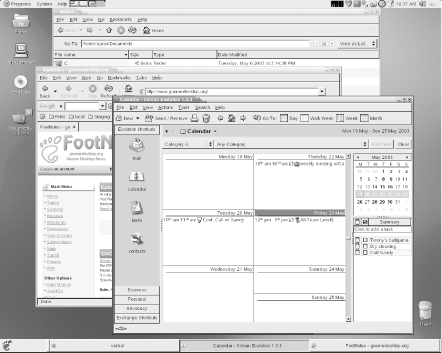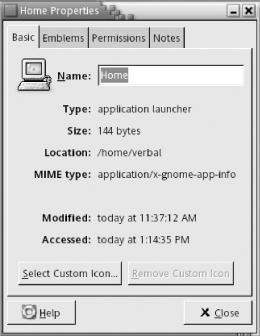|
|
|
17.1 Desktop OverviewFigure 17-1 shows the default GNOME desktop. The left side of the screen contains icons that are shortcuts to open applications, files, or URLs. The top icon is a link to the user's home folder; when double-clicked, it launches the Nautilus file manager to display the folder's contents. The other icons include shortcuts to the floppy drive and CD-ROM and links to web pages. In general, double-clicking on an icon leads to the most logical operation, so clicking folder icons displays folder contents, clicking application icons launches applications, and clicking a file opens the file in its most appropriate application (see Section 17.4.4.2 for information on how to choose which one). A button or icon you can press to start an application is called a launcher. You can drag and drop the icons around the desktop to arrange them as you like, or drag them onto the Trash icon to get them out of your way. Figure 17-1. The GNOME desktop You can also right-click on any blank space in the desktop and get a context menu that allows you to:
The bars across the top and bottom of the screen are called panels. Some distributions and configurations use only one, and others use more than two. GNOME allows you to create a variety of panels and choose their placement, size, and behavior. The one at the top, called the menu panel, is perhaps the most common and important. It may be slightly different in some distributions of GNOME, but it generally consists of two menus on the left, and a clock and application switcher on the right. Some systems may also include other small applications, called applets; see Section 17.2.3 for more information. If you do not have a menu panel, the desktop probably offers the
GNOME menu, which is similar to the Start
menu in Microsoft Windows. On most systems, it appears in the lower
left corner and is designated with a GNOME foot logo, earning it the
nickname "the foot menu." In Red
Hat 8.0, click the red hat to get the same menu with a list of
applications, help, and a few other tools, plus the logout and
screen-locking tools. If you want to add this GNOME menu to a panel,
right-click on any blank space in the panel and select Add to Panel
In general, the panel is a primary means of finding and opening applications and managing your desktop. You can add buttons to the panel to launch any application on your system; you can also include small applications, called applets, in the panel. For more information, see Section 17.2. GNOME allows you an enormous number of configuration options for your desktop environment. You can right-click on just about anything and get a pop-up menu (called a context menu) containing specific actions for that item and a way to configure its properties. General configuration settings are contained in the GNOME Control Center. You can access this tool by selecting System and then Settings in your menu panel (on some systems, look for Desktop Preferences under the Programs or Applications menu). For more information about settings, see Section 17.4. 17.1.1 Adding Desktop IconsDesktop icons offer convenient double-click access to your most important files, applications, and links. The items displayed on your desktop exist as files in the .gnome-desktop directory of your home directory. Anything you add to that directory will appear on the desktop. To add an icon that launches an application, select New Launcher. This opens the Desktop Entry Properties dialog box as shown in Figure 17-2. Provide the name of the launcher (this will be the text displayed underneath the icon), a comment (the tooltip that appears when the pointer is over the icon), and the command used to run the application. After you click OK, the new launcher icon appears on your desktop. Figure 17-2. Desktop entry properties A convenient use of desktop icons is to provide shortcuts to frequently used files or folders. Adding shortcuts is easiest from the file manager (Nautilus). Display the directory containing the item for which you want a shortcut on your desktop, right-click on the item, and select Make Link. Then click on the new link and drag it to the desktop, which has the underlying effect of moving it to your ~/.gnome-desktop folder. You can copy an item instead of moving it by pressing the Ctrl key while selecting and dragging the item. |
|
|
|